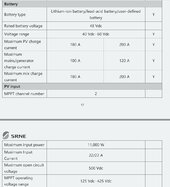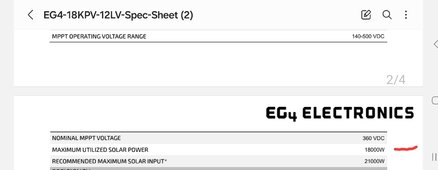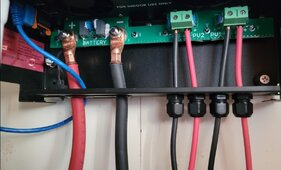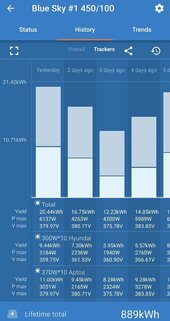Steve_S
Offgrid Cabineer, N.E. Ontario, Canada
I have been here a while and watching everyone running towards AIO's and for many good reasons BUT not seeing (looking) at the other side of this.
Every AIO has Solar Controllers - anywhere from 1 to 4 SCC's built-in (on average), sometimes more depending on model & sizing.
Each SCC is capable of outputting XX Amps for charging. Depends on how many Volts/Watts/Amps each can handle.
I looked through EG4 & Other spec sheets looking for how many AMPS of Charge is provided, be it collectively or individually. No Info Available !!!
Some do however state a max amperage incoming like 35A, 25A & 15A (in units with 3 SCCs for example.)
Now we have people installing 10,000W or more solar arrays to feed their AIO SCC's.
So Far So Good
I have Standalone SCC's.
#1 has 2080W (4s2p) provides 200V and gives 79A Charge. #2 has 2370W (2s3p) and provides 94A Charge,
4,450W providing 173A Charging
Edit: Thanks to 420OhmsPA: Clarifying, this is based on 24V System info but still.
--------------------------------------------------------------------
NOTICE SOMETHING ????
Are AIO's Penny Wise & Dollar Foolish ?
-------------------------------------------------------------------
To Vendors / Suppliers & Manufacturers even.
Clearly STATE the Amperage that EACH Internal SCC can provide with it's Maximum Solar Input Capacity.
QUESTIONS for @Will Prowse
Would it be possible for you to look at the assorted AIO's and provide such info or your observations with them in this regard.
Maybe have some of your friends from Signature, high-tech lab etc chime in as well...
(real, verifiable, credible & observable & reproduceable info only OK... no marketing shlock.)
*NB: When discussing StandAlone SCC's, I am referring to Midnite/Victron and similar, not bargain basement discount value gear.
---------------------------------------------------------------
The general question tossed into the pond.
I am frugal and squeeze the value out of the gear. Why would I spend on 10kw of panels when I can do better with 1/2 that (for charging) ?
Some may not care, others would who are on a tight budget and managing their cash.
What's your take ?
Every AIO has Solar Controllers - anywhere from 1 to 4 SCC's built-in (on average), sometimes more depending on model & sizing.
Each SCC is capable of outputting XX Amps for charging. Depends on how many Volts/Watts/Amps each can handle.
I looked through EG4 & Other spec sheets looking for how many AMPS of Charge is provided, be it collectively or individually. No Info Available !!!
Some do however state a max amperage incoming like 35A, 25A & 15A (in units with 3 SCCs for example.)
Now we have people installing 10,000W or more solar arrays to feed their AIO SCC's.
So Far So Good
I have Standalone SCC's.
#1 has 2080W (4s2p) provides 200V and gives 79A Charge. #2 has 2370W (2s3p) and provides 94A Charge,
4,450W providing 173A Charging
Edit: Thanks to 420OhmsPA: Clarifying, this is based on 24V System info but still.
--------------------------------------------------------------------
NOTICE SOMETHING ????
Are AIO's Penny Wise & Dollar Foolish ?
-------------------------------------------------------------------
To Vendors / Suppliers & Manufacturers even.
Clearly STATE the Amperage that EACH Internal SCC can provide with it's Maximum Solar Input Capacity.
QUESTIONS for @Will Prowse
Would it be possible for you to look at the assorted AIO's and provide such info or your observations with them in this regard.
Maybe have some of your friends from Signature, high-tech lab etc chime in as well...
(real, verifiable, credible & observable & reproduceable info only OK... no marketing shlock.)
*NB: When discussing StandAlone SCC's, I am referring to Midnite/Victron and similar, not bargain basement discount value gear.
---------------------------------------------------------------
The general question tossed into the pond.
I am frugal and squeeze the value out of the gear. Why would I spend on 10kw of panels when I can do better with 1/2 that (for charging) ?
Some may not care, others would who are on a tight budget and managing their cash.
What's your take ?
Last edited:







